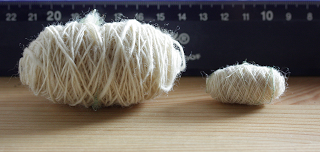I'm back home from a wonderful, relaxing holiday time, and now I'm settling down to the last preparations for the Textile Forum.
The whorls have been fired in the meantime, and they are now safely sitting in a box on my table, waiting to get equipped with a spindle stick each. Using the special "whorl-cookie cutters", that were custom made to my calculated measurements, worked really well. The whorls came out very much alike, they fit the sticks very nicely with their holes, and so I'm quite confident about the whorl part. I snuck back to work yesterday already, spending some time to portion and package the small parcels of wool to give out at the experiment, making sure that everybody gets the same amount of wool to work with.
Now there's the obligatory stack of e-mails to go through - as usual after being away for some days - and the last bit of preparation to make. And very soon it will be time to start writing the lists for packing and gather together all the stuff!
The whorls have been fired in the meantime, and they are now safely sitting in a box on my table, waiting to get equipped with a spindle stick each. Using the special "whorl-cookie cutters", that were custom made to my calculated measurements, worked really well. The whorls came out very much alike, they fit the sticks very nicely with their holes, and so I'm quite confident about the whorl part. I snuck back to work yesterday already, spending some time to portion and package the small parcels of wool to give out at the experiment, making sure that everybody gets the same amount of wool to work with.
Now there's the obligatory stack of e-mails to go through - as usual after being away for some days - and the last bit of preparation to make. And very soon it will be time to start writing the lists for packing and gather together all the stuff!




